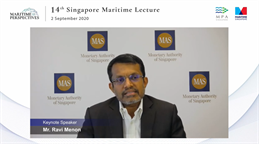
Ravi Menon, Managing Director of the Monetary Authority of Singapore (MAS) recently spoke at Singapore's Maritime Lecture, where he underscored the importance of building resilience post-COVID-19.
While there are beliefs that moving supply chains is the way to go, he noted that making it more diverse, more flexible and more integrated will make supply chains more resilient.
“There is a view in some quarters that resilience means onshoring and retreating from global value chains. With the border restrictions in the wake of COVID-19, there has indeed been some onshoring of supply chains to secure essential goods and services, but it is not practical for most activities to be onshored and it will be costly and inefficient to do so,” Menon said during the lecture initiated by the Maritime and Port Authority (MPA) of Singapore.
Menon said diversified supply chains will be more resilient with multiple sources of raw materials, multiple production locations, and multiple warehouse hubs and distribution channels.
“China plus one” strategy
He noted though that the desire to mitigate China concentration risk has led to some diversification of production in Asia.
“Even before COVID-19, firms had started to adopt a “China plus one” sourcing and production strategy as wage costs rose in China and US-China trade tensions intensified,” Menon said.
New production locations and value chains have emerged in Vietnam, Taiwan, and to some extent Malaysia, and he said the COVID-19 pandemic has "added some impetus” to this trend.
“But we do not expect extensive relocation of production out from China in the near term,” the MAS managing director added, further explaining that the middle-class consumption patterns are boosting and reshaping intra-Asian trade in goods and services.
“Supply chains that used to focus on Asian exports to Europe and America are increasingly diversifying to also meet final demand in Asian markets,” Menon said.
“This means more regional trade routes and regional ports growing in importance.”
In 2019,12 of the top 15 container ports in the world were in Asia with Shanghai leading the list, followed by Singapore, Ningbo-Zhoushan, Shenzen, and Guangzhou on the top tier.
“Just-in-time to just-in-case operations”
Menon said by making supply chains flexible, it would also be more resilient to shocks and disruptions such as the ongoing coronavirus crisis.
Making supply chains flexible means focusing on where production can ramp up or down in line with changing demand and where alternative routes can be used quickly.
“In the wake of the COVID-19 pandemic, there is no doubt a rebalancing from just-in-time to just-in-case operations,” Menon said. “But while inventories are likely to be somewhat larger going forward, maintaining huge stockpiles is expensive.”
“Smart firms are recognizing the value of flexible supply chains and exploring alternative production possibilities from the stocks on hand.”
The Singapore Monetary Authority official said improved visibility and transparency on shipments can also help make supply chains more flexible and resilient.
“Of course, it is not as easy to retrofit ships to carry different types of cargo as it is for airlines to convert passenger planes to cargo planes, but the shipping and logistics industries can use digital technologies to improve co-ordination of supply chains, have more timely notifications of shipment delays, and enhance fleet management and route optimisation,” he added.
Rise of e-commerce
Menon also said the rise of e-commerce platforms has launched a move towards end-to-end supply chain integration.
He noted that e-commerce behemoths like Amazon and Alibaba, for example, are challenging traditional logistics players by developing their own warehouses and fulfilment centres.
He said since digital connectivity cannot fully replace physical connectivity because goods still have to be moved, businesses are adopting “omnichannel” marketing and distribution approaches, connecting with suppliers and customers both online and offline.
“Integrated supply chains also mean strong inter-linkages across adjacent sectors – maritime, aviation, rail and road transport, with trading, logistics, and finance,” Menon added.




